About Delhi (New Delhi & Old Delhi) Tour Information
- Area: 14 83 sq .kms.
- Altitude: 239 m above sea level.
- Language: Hindi, English Urdu, Punjabi
- Rainfall : 111 cms. annually (approx)
- Clothes : Summer-Cotton, Winter- Woollens
- STD Code: 011
- Population: 11 million
- People per sq.km : 7000
- Best Time to Go : October to March
Delhi, the capital of India, is a city of marvellous contrast. Its past and present mesh seamlessly to make it an exciting palace to visit. The sprawling modern metropolis of Delhi enfolds within its limits the remains of seven earlier cities. Today the imposing forts and tombs of these earlier times co-exist comfortable with the elegant edifices of the British Raj and modern high rise buildings. Cool tree-lined avenues with their whitewashed bungalows are as much a part of the city's charms as the ordered chaos of the arrow lanes and busy bazaars of the walled city of Shahjahanabad.
A major gateway into India, Delhi is the logical start to an exploration of northern India. It is also a part of the Golden Triangle, an exciting circuit of the three magnificent Cities of Delhi-Agra -Jaipur. places
History of Delhi
Delhi has not always been the capital of India but it has played an important role in Indian history. The settlement of Indraprastha, which featured in the epic Mahabharata over 3000 years ago, was located approximately on the site of present -day Delhi. Over 200 years ago, Pataliputra (near modernday Patna) was the capital of Emperor Ashoka, kingdom More recently the Mughal emperors made Agra the capital through the 16th and 17 centuries. Under the British, Calcutta was the capital until the construction of New Delhi in 1911. Of course, it is only comparatively recently the India as we know it has been unified as one country. Even at the height of their power the Mughals did not control the sough of India, for example. But Delhi has always been an important city or a capital of the northern region of the subcontinent.
The have been at least eight cities around modern Delhi. The first four were to the sough around the area where the Qutab Minar stands. The earliest known Delhi was called Indraprastha and was centered newer present-day Purana Qila. At the beginning of the 12th century the last Hindu kingdom of Delhi was ruled by the Tomara and chauthan dynasties and was also near the Qutab Minar and Suran Kund, now in Haryana.
The city was followed by Siri, constructed by Ala-ud-din near present-day Haunz Khas in the 12th century. The third Delhi was Tughlaqabad, now entirely in ruins,. which stood 10 km sough-east of the Qutub Minar. The fourth Delhi dates from the 14th century and was also a creation of the Tughlaqs. Known as Jahanpanah, it also stood near the Qutab Minar.
The fifth Delhi, Ferozabad, was sited at Feroz Shah Kotla in present-day New Delhi Its ruins contain al Ashoka pillar, moved here from elsewhere, and traces of a mosque in which Tamer lance prayed during his attack on India.
Delhi has seen many invaders through the ages. Tamer lane plundered in the 14th century; the Afghan Babur occupied it in the 14th century; the Afghan Babur occupied it in the 16th century, and in 1739 the Persian emperor, Nadir Shah, sacked the city and carted the Kohinoor Diamond and the famous peacock Throne off to Iran. The British captured Delhi in 1803 but during the Indian Mutiny of 1857 it was a centre of resistance against the British.
Delhi Monuments Information....

Humayun's Tomb
Humayun's Tomb, the red and white structure, was raised by his widow, Haji Begum, as a tribute in his memory in the 16th century. This building which is supported by a lofty, double-storeyed gateway costs 1.5 million rupees.
It is set in the centre of a huge square garden which is enclosed by high walls on three sides. The garden is divided into four parts by wide causeways and water channels, with each square further divided into even smaller squares by pathways, a characteristic of the Mughal era.
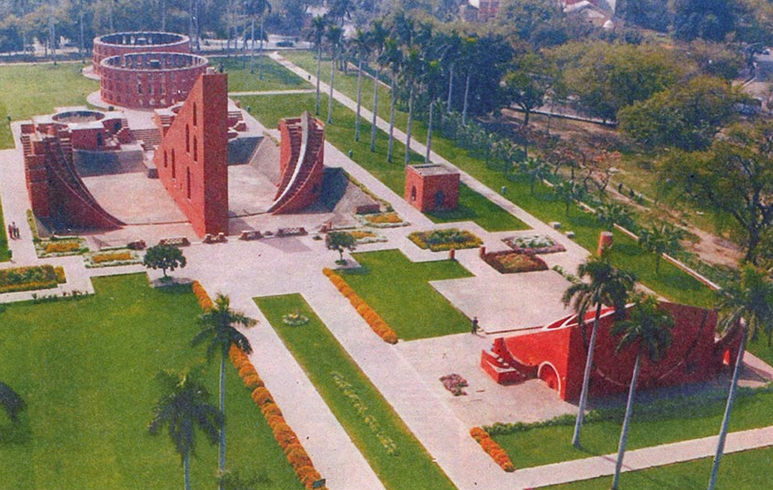
Jantar Mantar
Built in 1725 by Maharaja Jai Singh II of Jaipur, Jantar Mantar is a huge sun-dial known as the Prince of Dials. It was also used to observe the movements of stars and planets. The instruments at Jantar Mantar are fascinating for their novel approach. However, it has now become impossible to predict the time accurately because of the towering buildings that surround it. Recently the area has been restored to it's pristine glory.

India Gate
Straight down the road from Rashtrapati Bhavan is India Gate. Designed by Lutyens, the 42 mt high structure is a war memorial in honour of the soldiers who died during the second world war. The imposing structure from where the massive lush green lawns streches, has an eternal flame (amar jawan jyoti) to honour the memory of the unknown soldiers.
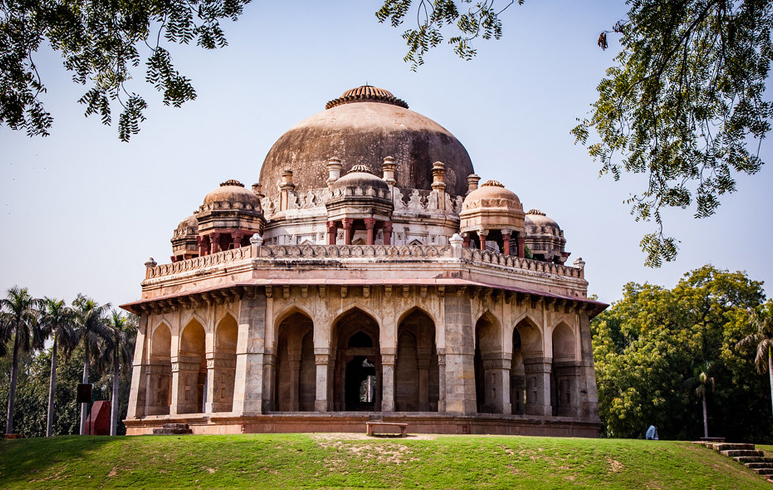
Lodi Tomb
Said to be the remains of another city that was sought to be built in Delhi, the tombs are in the midst of the famed Lodhi Gardens and is believed to have been built by rulers of two dynasties, the Sayyaids and the Lodis.
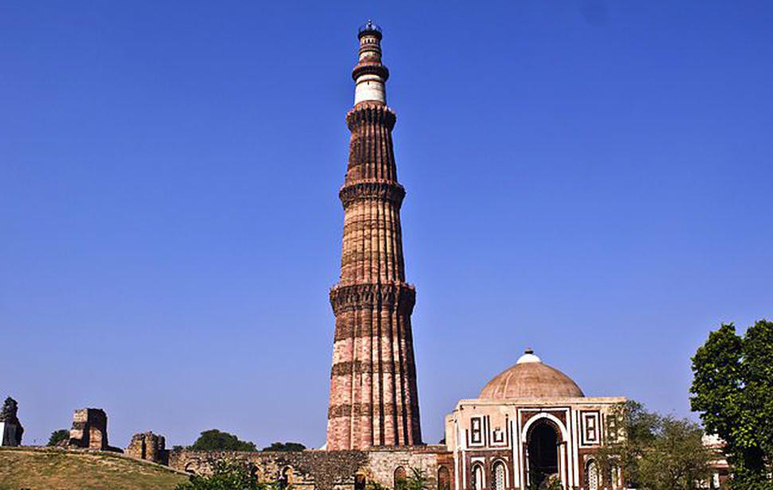
Qutub Minar Complex
13 km to the south of Connaught Circus at Lalkote of 8th century Tomor Rajputs, the 72.5 m high Victory Pillar stands as a victory stand of a Muslim King Kutub-ud-din-Aibak in India. At Kila Roy Pithora, on the dilapidated fort of the last Hindu king Prithwiraj, this victory stand was made like throne in Gajni. In 1199 Kutub-ud-Din started its construction and it was completed in 1236 by Iltutmish, the son-in-law of Kutub. However, there is a 2nd opinion. Some say, the construction came to an end around 1357-68 during the reign of Feroz Sah Tughlak.
However, the Kutub which was built in Afghan style underwent repairing and remaking for more than occasions. Revolving steps of flights are 367 in number in slightly leaned Kutub. It has some spl features- at its root the radius is being 14.40 m which gradually reduced at its top to 2.44 m. In Kupee language it has been inscribed on Kutub that- The Tower was erected to cast the shadow of God over both East and West. Aayaat from Quran is also inscribed. At the foot of the Minar a Mosque was built in 1197.
The 5 storeyed Qutub Minar is a remarkable instance of sculpture in India. The 1st floor made of sand stone by Kutub, the 2nd & 3rd floors made of sand stone by Iltutmis and the 4th and 5th in both sand stone and marble by Feroz Shah Tughlok in 1368.
However, the earthquake of 1803 destroyed it , in 1829 British Major Robert Smith re-built the tomb. Later the tomb was brought down from the Minar and reset it in the garden beside. In 1981, some students died of stampade while on their way up the steps of flights. Since then, ascending 5th floor is forbidden and not more than a group of 4 at a time is permitted to ascent only upto 1st floor of Kutub. Recently, Kutub is enshrined with huge lighting

Safdarjung's Tomb
It is 5 km to the S-West from Connaught Place at Arvind Marg on the way to Kutub. Between 1753-74, Nawab Suja-ud-Dulla erected Safdarjung on the graveyard of Nawab of Ayodhya Mirza Mukim Abul Mansur Khan, like the tomb of Humayun. In the middle of Mughal Garden Charbagh, it is the last tomb or graveyard of 40 ft high. On the 4 sides, there are 4 stone made Azan Minar. In the courtyard, there is rose garden.
Beside it, mini airport, Safdarjung of Delhi Flying Club is located. In 1980, Sanjay Gandhi died in an air crash in this airport. Adjacent to the south, there is the battle field, where Mahammad Shah Tughlak was defeated by Taimur in 12 Dec, 1398.

Tughlaqabad
The Tomb of Ghiyasuddin Tughlaq lies 8km east of the Qutab complex. The fort is partially in ruins, but still worth a visit. A well preserved tomb which lies south of the fort is a fine example of Tughlaq architecture.
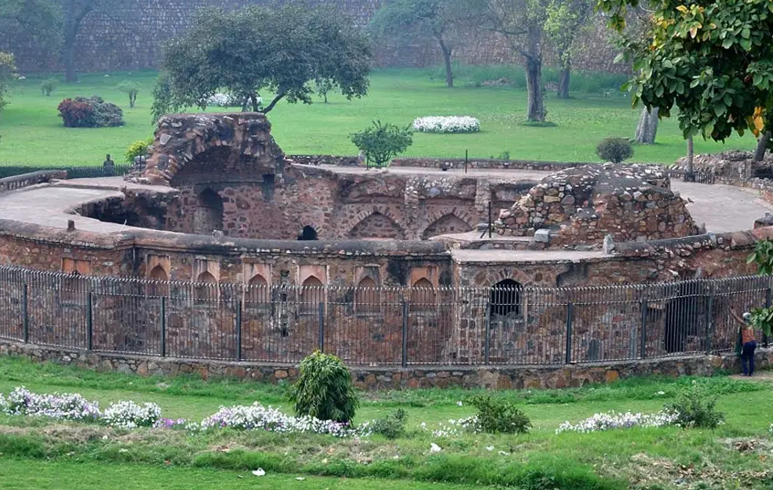
Feroz shah Kotla
Erected by Feroz Shah Tughlaq in 1354, the ruins of Ferozabad, the fifth city of Delhi can be found at Feroz Shah Kotla, Just off Bahadur Shah Zafur Marg between the old and new Delhi's. In the frortress-places is a 13-metre-high sadstone Ashoka pillar inscribed with Ashoa's edicts The remains of an old mosque and a fine well can also be seen in the area, but most of the ruins of Ferozabad were used for the construction of later cities.
Palaces of Worship in Delhi Information....
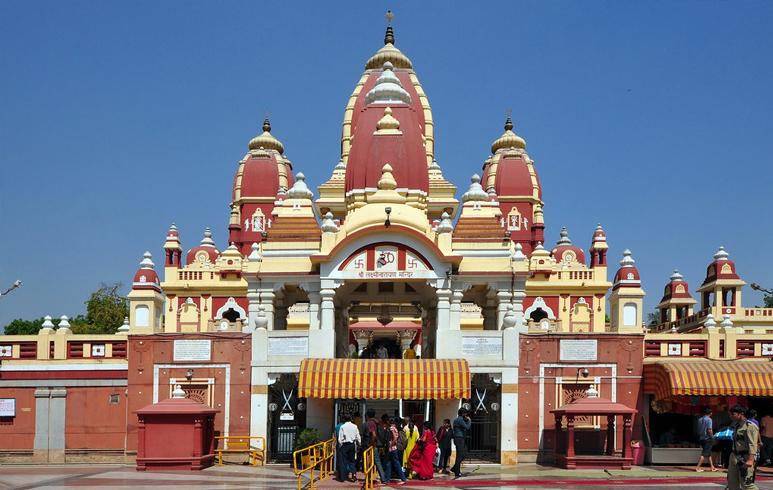
Lakshminarayan Temple
Birla Mandir, DelhiThe Laxmi Narayan Mandir (temple) built by B.D. Birla is a modern Hindu temple dedicated to Laxmi (goddess of wealth) and Narayana (the preserver). It was inaugurated by Gandhi with the stipulation that it should be open to all castes (including the untouchables) and all faiths, so it is more welcoming to foreigners than the average temple.
After visiting so many ancient Hindu temples, it was fun to see a modern functioning one. The whole temple was quite garish, and noisy with chants over the loud speaker system, but it was also strangely peaceful. In the garden there was a tree wound with colored strings, and two women were praying at the foot.
History : This temple was built over a six year period (1933 - 1939) and was opened by Mahatma Gandhi.
Temple Architecture : The highest tower in the temple reaches a height of 165 feet while the ancillary towers reach 116 feet. The Geeta Bhavan, a hall is adorned with beautiful paintings depicting scenes from Indian mythology. There is also a temple dedicated to Buddha in this complex with fresco paintings describing his life and work. The entire complex, especially the walls and the upper gallery are full of paintings carried out by artists from Jaipur in Rajasthan. The rear of the temple has been developed as an artificial mountainous landscape with fountains and waterfalls.
Significance : This is one of the landmarks in the nation's capital New Delhi. It was built in the 20th century by the Birla family of industrialists known for its many other temples in India. It is modern in concept and construction. It attracts several devotees and international tourists. The presiding deity here is Lakshmi Narain (Vishnu).
Other Shrines in the temple
Durga and Shiva are the other major deities housed in this temple. Mention must be made of the Buddha temple in this complex. Access and Accommodation: Accomodation is available in the temple guest house for out of town travellers especially for international scholars pursuing knowledge in Sanskrit or in the Hindu religion.
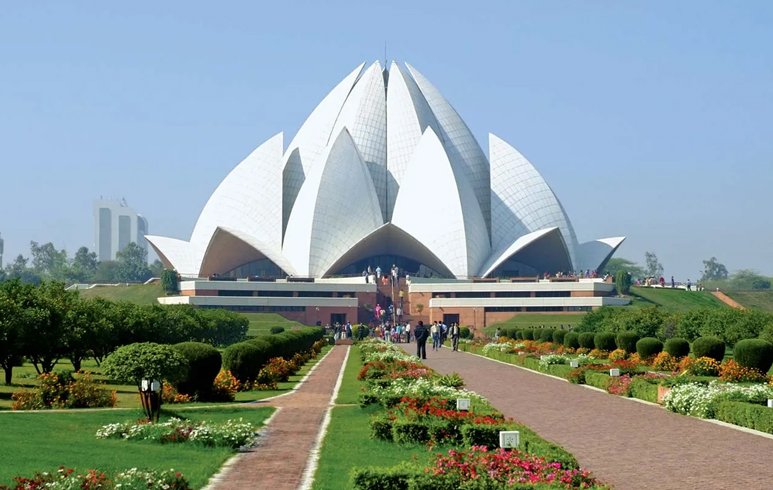
Lotus Temple
Lotus Temple - DelihBaha'i Temple, is known as one of the most beautiful architectural temples in India. Popularly called Lotus Temple as it is built in the shape of a Lotus flower and reaches a height of more than 40m. It was completed in 1986 and one can enjoy its exquisite beauty even from a kilometre distance, at night. The House of Worship is surrounded by nine large pools of water that not only enhance the beauty of the building, but also play a significant role in the natural cooling system of the prayer hall. An adjunct of the main building is its ancillary building which houses offices, a conference hall, a library and an audio-visual room.
The common characteristic of Bahá’i Houses of Worship is that they are all nine-sided. Nine is the highest digit and symbolises comprehensiveness, oneness and unity. Within the prayer hall only the Holy Scriptures of the Bahá'í Faith and earlier Religions are read or recited, according to arranged programmes. At other times, all are welcome to meditate and pray in silence. No lectures are permitted, nor any rituals performed in the prayer hall.

Rajghat
4 km away from Janpath to the N-East of Feroz Shah near Delhi Gate at Ring Rd on the bank of Jamuna situated Rajghat. Jawaharlal Nehru Rd also ends opp. Rajghat. On 31st Jan. 1948, Mahatma Gandhi's last rites was performed here. The memorial stone of Gandhi is square in shape made of black stone. His last ward- 'Hey Ram' is inscribed on it.
Ordinary people, VIPs, foreign tourists all come here at Rajghat to pay their homage to him. On every Friday (the day of his death) a prayer is being held. Except Monday, a regular feature of projecting Gandhi philosophy in picture, sculpture and photos from 10-00 to 17-00 is being performed at Rajghat. Besides, there is Gandhi Memorial Museum projecting his life and the philosophy of Sarvodaya Movement in film from 9-30 to 17-30 except Thursday and on Sunday at 16-00 in Hindi and 17-00 in English.
Another Gandhi memorial is Gandhi Balidansthal or assassinated spot at Tis January Marg of the city. On 30 Jan. 1948 on his way to prayer at Biral Bhawan , he was assassinated by bullets. Hence, this memorial.